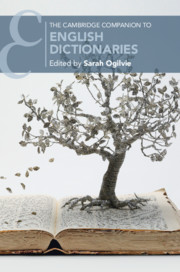Book contents
- The Cambridge Companion to English Dictionaries
- The Cambridge Companion to English Dictionaries
- Copyright page
- Dedication
- Contents
- Illustrations
- Tables
- Notes on Contributors
- Acknowledgements
- Chronology
- Chapter 1 Introduction
- Part I Issues in English Lexicography
- Chapter 2 How a Word Gets into an English Dictionary
- Chapter 3 Technology and English Dictionaries
- Chapter 4 Diachronic and Synchronic English Dictionaries
- Chapter 5 Description and Prescription: The Roles of English Dictionaries
- Chapter 6 European Cross-Currents in English Lexicography
- Chapter 7 English Slang Dictionaries
- Part II English Dictionaries Throughout the Centuries
- Part III Dictionaries of English and Related Varieties
- Guide to Further Reading
- Index
- Cambridge Companions to Literature
Chapter 6 - European Cross-Currents in English Lexicography
from Part I - Issues in English Lexicography
Published online by Cambridge University Press: 18 September 2020
- The Cambridge Companion to English Dictionaries
- The Cambridge Companion to English Dictionaries
- Copyright page
- Dedication
- Contents
- Illustrations
- Tables
- Notes on Contributors
- Acknowledgements
- Chronology
- Chapter 1 Introduction
- Part I Issues in English Lexicography
- Chapter 2 How a Word Gets into an English Dictionary
- Chapter 3 Technology and English Dictionaries
- Chapter 4 Diachronic and Synchronic English Dictionaries
- Chapter 5 Description and Prescription: The Roles of English Dictionaries
- Chapter 6 European Cross-Currents in English Lexicography
- Chapter 7 English Slang Dictionaries
- Part II English Dictionaries Throughout the Centuries
- Part III Dictionaries of English and Related Varieties
- Guide to Further Reading
- Index
- Cambridge Companions to Literature
Summary
In early modern Europe, international communication in Latin was increasingly counterbalanced by the growth of language contact and exchange among Europeans who favoured the vernacular languages over the classical ones. Not surprisingly, this resulted in the production of dictionaries, initially bilingual and polyglot, and later monolingual, of a large number of languages. Given this context, this chapter studies how the English language and English lexicography were slowly involved in the development of the European tradition of dictionary-making. A number of polyglot, bilingual, and trilingual dictionaries are surveyed in order to show their reciprocal influences and the Continental impact on English dictionaries: in fact, polyglot dictionaries grew out of bilingual ones, bilingual dictionaries were made into trilingual ones, the wordlists of monolingual dictionaries were sometimes taken from bilingual ones, etc. It will also be shown how a few monolingual English dictionaries were related, directly or otherwise, to Continental sources. The chapter will finally focus on Samuel Johnson’s Dictionary in order to highlight how it was influenced by Continental models and how, in turn, it exerted its influence on European lexicography.
Keywords
- Type
- Chapter
- Information
- The Cambridge Companion to English Dictionaries , pp. 58 - 74Publisher: Cambridge University PressPrint publication year: 2020
- 1
- Cited by



